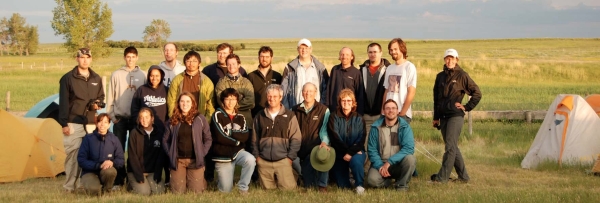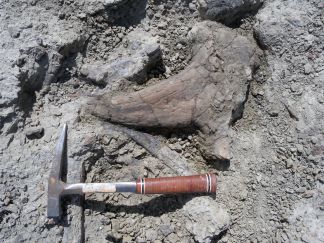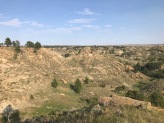Fieldwork
Because new fossil discoveries contribute greatly to our understanding of the history of life, our lab is active in the field, searching for and collecting dinosaurs and other vertebrate fossils. We work with our colleagues to organize and conduct fieldwork in southern Alberta, the Canadian high arctic, Uruguay, Sudan, Mongolia and South Africa. These projects have the potential to reveal new dinosaur species and to contribute to our knowledge of poorly known geographic regions or temporal intervals in dinosaur evolution.
SOUTHERN ALBERTA DINOSAUR PROJECT
Current fieldwork in Alberta is directed in the Milk River region along the Montana border, and is part of a multi-year collaborative field research project organized and initiated with colleagues from the Cleveland Museum of Natural History and the Royal Tyrrell Museum. This area contains some of the oldest dinosaur-bearing sediments in Alberta, and has potential to reveal new dinosaur species and to contribute to our knowledge of a poorly known time in Late Cretaceous dinosaur evolution.
The geology and paleontology of the Late Cretaceous of Alberta has been intensely studied, but directed in large part toward regions with large amounts of its easily accessible outcrop. The region in and around Dinosaur Provincial Park has been particularly well sampled, with over 400 articulated or associated dinosaur skeletons having been collected from this locality in approximately 100 years. New research reveals significant faunal turnovers with the most fossiliferous series of rock layers, the Dinosaur Park Formation that may be related to environmental change related to sea-level rise. From this dataset, a habitat-tracking model makes a number of predictions regarding the distribution of individual genera and species: taxa in the upper part of the formation can be hypothesized be more common in more coastally-influenced lower coastal plain sediments, whereas those taxa found low in the formation are expected to be more common in more inland, upper coastal plain settings. Also the high species turn over rates and chance discoveries suggest that the poorly known sediments of the lower Belly River Group may contain an entirely new and distinctive dinosaur fauna. Due to poor sampling in regions outside of Dinosaur Provincial Park, further fieldwork is required to test these hypotheses and determine the nature of the faunal shifts within the Belly River Group.

The 2009 Southern Alberta crew
The vertebrate fossil resources of the Milk River region of extreme southern Alberta have received relatively little attention, although small collections of fossils made by former ROM scientists Lorris Russell (in 1936, 1949-50) and Gordon Edmund (in 1966-67) are noteworthy, along with contributions by the Royal Tyrrell Museum more recently. Fossiliferous strata are particularly well exposed adjacent to the Milk River, over 125 km southeast of Dinosaur Provincial Park. This area contains some of the oldest dinosaur-bearing sediments in Alberta (Milk River, Foremost, and lower Oldman formations), as well as significant portions of the Oldman and Dinosaur Park formations that are time-equivalent to the section exposed at Dinosaur Provincial Park. We are currently engaged in a long-term fieldwork project that aims to execute a complete paleontological survey of this area, with the goals of compiling a detailed biostratigraphic framework for this region that can be compared directly to the datum now in place for the Dinosaur Provincial Park locality and to document the poorly known dinosaur fauna of the lower half of the Belly River Group and the Milk River Formation. This fieldwork is part of a multi-year collaborative project with Dr. Michael J. Ryan (Cleveland Museum of Natural History) and the Royal Tyrrell Museum, and it has potential to uncover more new dinosaur taxa and contribute to our knowledge of a poorly known time in dinosaur evolution.
Collaborators: Michael J. Ryan (Cleveland Museum of Natural History), David Eberth (Royal Tyrrell Museum), Philip Currie (University of Alberta)
Associated Publications
Ryan, Michael; Holmes, Robert; Mallon, J; Loewen, M. and Evans, D C. 2016. A basal ceratopsid (Centrosaurinae: Nasutoceratopsini) from the Campanian Oldman Formation (Campanian) of Alberta, Canada. Canadian Journal of Earth Sciences. Free PDF here.
Cullen, T. and D. C. Evans. 2016. Palaeoenvironmental drivers of vertebrate community composition in the Belly River Group (Campanian) of Alberta, Canada, with implications for dinosaur biogeography. BMC Ecology 16:52. DOI: 10.1186/s12898-016-0106-8
D. C. Evans and M. J. Ryan. 2015. Cranial Anatomy of Wendiceratops pinhornensis gen. et sp. nov., a Centrosaurine Ceratopsid (Dinosauria: Ornithischia) from the Oldman Formation (Campanian), Alberta, Canada, and the Evolution of Ceratopsid Nasal Ornamentation. PLoS ONE 10(7): e0130007. doi:10.1371/journal.pone.0130007
Chiba, K., M. J. Ryan, D. A. Eberth, D.Braman, Y. Kobayashi and D. C. Evans. 2015. Taphonomy of a Centrosaurus apertus (Dinsoauria: Ceratopsidae) bonebed from the Oldman Formation of Alberta, Canada. Palaios 30(9):655-667.doi: http://dx.doi.org/10.2110/palo.2014.084
Evans, D. C., R. Schott, D. Larson, C. M. Brown, and M. J. Ryan. 2013. The oldest North American pachycephalosaurid and the hidden diversity of small-bodied ornithischian dinosaurs. Nature Communications 4:1828. doi:10.1038/ncomms2749
Ryan, M. J., D. C. Evans, and K. Shepherd. 2012. A new ceratopsid from the Foremost Formation (middle Campanian), Alberta. Canadian Journal of Earth Sciences 49: 1251–1262. Available here.
Ryan, M. J., D. C. Evans, P. J. Currie, C. M. Brown, and D. Brinkman. 2012. New leptoceratopsids from the Upper Cretaceous of Alberta, Canada. Cretaceous Research 35: 69-80. Available (subscription) here.
Larson, D. W., N. R. Longrich, D. C. Evans, M. J. Ryan. 2012. A new species of Neurankylus from the Milk River Formation (Cretaceous: Santonian) and a revision of N. eximius. Gafney Turtle Symposium Volume. Spring-Vrlag Press.
Schott, R. K., D. C. Evans, T. E. Williamson, T. D. Carr, and M. B. Goodwin. 2009. The anatomy and systematics of Colepiocephale lambei (Dinosauria: Pachycephalosauridae). Journal of Vertebrate Paleontology 29(3): 771-786.
CRETACEOUS TERRESTRIAL VERTEBRATES OF SUDAN
Most of our knowledge of Late Mesozoic terrestrial vertebrate faunas comes from fossil deposits in the New World, Europe, and Asia, whereas from Africa there is only little information based on a few isolated localities. In particular the northeastern part of the continent has so far remained dramatically understudied. We are currently exploring the poorly known fauna of Late Mesozoic terrestrial vertebrates of the eastern Saharan Africa by performing paleontological fieldwork in Upper Cretaceous sediments of central northern Sudan, which promise to provide invaluable insights into the patterns of vertebrate diversity in northeastern Gondwana shortly before the K/T extinction event. The project is a collaboration between Johannes Muller at Humboldt University in Berlin, the Technical University Berlin (both Germany), the Royal Ontario Museum Toronto (Canada), and the Geological Research Authority of Sudan.
Associated Publications:
Owusu Agyemang P., E. M. Roberts, R. Bussert, D. Evans, J. Müller. (In review). U-Pb Detrital zircon constraints on the depositional age and provenance of the dinosaur-bearing Wadi Milk Formation of Sudan. Cretaceous Research.
Klein, N., Bussert, R., Evans, D. C., Salih, K., Eisawi, A. A. M., Nafi, M., and Müller, J. 2016. Turtle remains from the Wadi Milk Formation (Late Cretaceous) of Northern Sudan. Palaeobiodiversity and Palaeoenvironments: DOI 10.1007/s12549-015-0225-9
Salih, K. A. O., D. C. Evans, R. Bussert, N. Klein, M. Nafi, and J. Muller. 2015. First record of Dyrosauridae (Crocodyliformes) from the Upper Cretaceous Shendi Formation of Sudan. Journal of Vertebrate Paleontology. DOI: 10.1080/02724634.2015.1115408.
ROM HELL CREEK PROJECT
The pattern of terrestrial biodiversity leading to the terminal Cretaceous extinction event continues to be hotly debated, with differing hypotheses on the ultimate causes of this major ecological catastrophe in Earth History. In 2018, the Royal Ontario Museum started a new, 5-year field research initiative to collect dinosaurs and other fossils from the twilight of the Dinosaur Age, the Hell Creek Formation of Montana, and contribute to our understanding of the extinction that end the dinosaur’s reign and paved the way for mammals to inherit the Earth. A better understanding of the evolutionary and ecological dynamics of dinosaurs as they relate to climate change leading up to the end-Cretaceous extinction event will shed new light on the causes and consequences of mass extinctions in general, which is pertinent to the biodiversity crisis we are facing today. This major field project will result in the collections of hundreds of new fossils, including other dinosaurs that lived alongside T. rex, such as the iconic herbivore Triceratops, as well as the rest of its fragile ecosystem. These fossils will fill in a gap in the ROM dinosaur collections, and the project will also provide opportunities for numerous student research projects through participation in this exciting field research project.
The field season of 2018 was the first season of this 5-year project. Our first year was primarily a surveying year, and our team made some exciting discoveries. Wendy Sloboda found dinosaur eggshell- a rarity for the area, but the find of the year was a beautifully preserved Triceratops skull found by ROM palaeoartist Danielle Dufault on the second last day of the field season. It looks like a great prospect, and we will be back in 2019, to dig it up. While we are digging up the skull, we will continue to prospect for new fossils, including a Tyrannosaurus rex. All the while, trying to learn more about the enigmatic extinction of the dinosaurs.
Associated Publications:
. 2017. A nestling-sized skeleton of Edmontosaurus (Ornithischia, Hadrosauridae) from the Hell Creek Formation of northeastern Montana, U.S.A., with an analysis of ontogenetic limb allometry, Journal of Vertebrate Paleontology, 37:6, DOI: 10.1080/02724634.2017.1398168
Larson, D.W., C. M. Brown, and D. C. Evans. Dental Disparity and Ecological Stability in Bird-like Dinosaurs prior to the End-Cretaceous Mass Extinction. Current Biology: DOI: http://dx.doi.org/10.1016/j.cub.2016.03.039






